
Photo 2: Roseslug larvae.
| Three species of sawflies | (Roseslug, Endelomyia aethiops: Bristly roseslug, Cladius difformis; and curled rose sawfly, Allantus cinctus) |
Identification
 Photo 2: Roseslug larvae. |
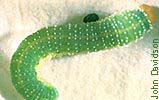 Photo 3: Curled rose sawfly larvae. |
Scouting
Rose sawflies produce damage called skeletonization by chewing away a layer of the leaf except for the veins. The thin layer remaining turns clear or brown and the uneaten veins appear like a skeleton. The older larvae of the bristly roseslug and curled rose sawfly chew holes rather than skeletonizing the leaves.
 Photo 4: Roseslug and skeletonizing of leaf on right side of photograph. |
Begin to scout for sawfly larvae in early May. Roseslugs feed through June and are not seen again until the next spring. The curled rose sawfly also has one generation per year. The bristly roseslug has several generations throughout the summer. Sawflies often feed on the undersides of leaves, so inspect all leaf surfaces.
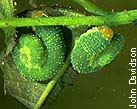 Photo 5: Curled rose sawfly and leaf defoliation. |
Control
Sawflies are best controlled when young. Several options exist for control. A physical tactic is to simply pick them off by hand. Dislodging them with a stick or a stream of water also works. If using water be sure to spray early enough in the day to allow foliage to be dry by sunset so as not to create favorable conditions for fungal development. Horticultural oil, insecticidal soap and azadirachtin (sometimes called neem), are low-toxicity biorational insecticides for young sawflies. Azadiractin is slower acting. Bacillus thuringiensis (Bt) is effective on young lepidoptera caterpillars but NOT on larval sawflies. Conventional insecticides include acephate (Orthene), carbaryl (Sevin), chlorpyrifos (Dursban),
and malathion. Avoid spraying the rose flowers as many conventional insecticides are highly toxic to bees.
Japanese beetle (Popillia japonica)
Identification
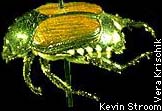 Photo 6: Japanese beetle. |
Scouting
One of the favored foods of adult Japanese beetles is rose foliage and flowers, although adults feed on many plant species. Larvae feed on the roots of grasses. Inspect your plants for skeletonized leaves and the presence of adult beetles.
Control
the Minnesota Department of Agriculture has a quarantine on Japanese beetles as of 1997. Report any sightings to the Minnesota Department of Agriculture at (612) 296-3343. Control is the same as the rose chafer.
False Japanese beetle (Strigoderma arbicola)
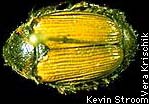 Photo 7: False Japanese beetle. |
Scouting
This insect has not been studied extensively. Larvae feed on plant roots, but a species list is not well known. Adults are found on wild and cultivated roses. When numbers of adults are large, the beetles damage roses by feeding on buds and flowers.
Control
Control is the same as for the rose chafer.
Rose chafers (Macrodactylus subspinosus)
 Photo 8: Rose chafer. |
Identification
Rose chafers are scarab beetles approximately 3/8 inch (8-9 mm) long, slender, light tan, and lacking the white hair tufts of Japanese beetles.
Scouting
Rose chafers are generally found in areas with sandy soil. Adults feed on rose flowers and foliage. The larvae feed on the roots of grasses, alfalfa, or clover sod. Inspect your plants for skeletonized leaves and adult beetles.
Control
While rose chafers can be numerous, hand pick if infestation is light. The insecticides carbaryl (Sevin), acephate (Orthene), and chlorpyrifos (Dursban) control these beetles. However, the beetles are quite mobile and new beetles may replace those killed by insecticides. Avoid spraying flowers so as to not kill bees.
Fuller rose beetle (Asynonychus godmani)
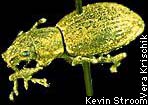 Photo 9: Fuller rose beetle. |
Identification
The fuller rose beetle is a weevil with a short snout. The adult weevil is brown with black mottled markings and about 5/8 inch (14-15 mm) long.
Scouting
Both larvae and adults are pests. Larvae feed on roots while the adults chew foliage and flowers. Adults generally feed during the night and are considered to be more damaging.
Control
Control is similar to other beetle defoliators. Hand picking at night is an option with low populations. Control is the same as for the rose chafer.
Leafcutting bees (Megachile spp.)
Identification
Leafcutting bees are similar in size to honeybees, but are blackish in color.
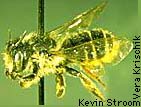 Photo 10: Leafcutting bee. |
Scouting
Leafcutting bees cut out sections of rose and other plant leaves to line their nests. The damage of leafcutting bees is quite distinctive. The holes are large and round with a smooth edge. The edges of holes chewed by most insects are irregular or ragged.
Control
Control of leafcutting bees is not recommended because they are beneficial pollinators.
| HOME: Insect Pests of Roses | NEXT: Piercing/sucking feeders |